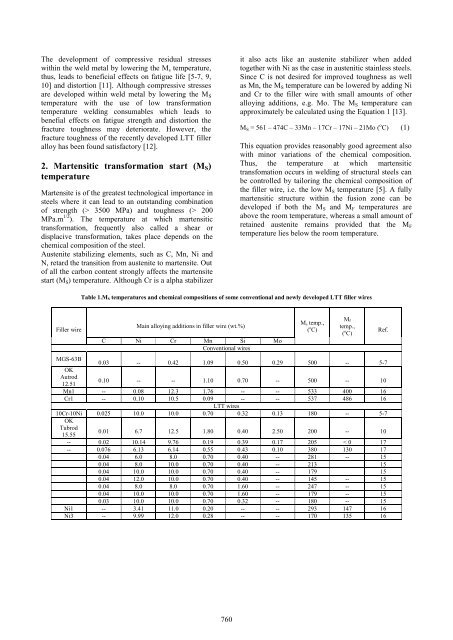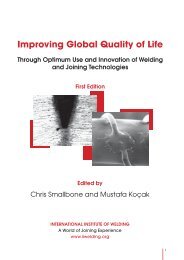(LTT) Filler Wires
(LTT) Filler Wires
(LTT) Filler Wires
You also want an ePaper? Increase the reach of your titles
YUMPU automatically turns print PDFs into web optimized ePapers that Google loves.
The development of compressive residual stresses<br />
within the weld metal by lowering the M s temperature,<br />
thus, leads to beneficial effects on fatigue life [5-7, 9,<br />
10] and distortion [11]. Although compressive stresses<br />
are developed within weld metal by lowering the M S<br />
temperature with the use of low transformation<br />
temperature welding consumables which leads to<br />
benefial effects on fatigue strength and distortion the<br />
fracture toughness may deteriorate. However, the<br />
fracture toughness of the recently developed <strong>LTT</strong> filler<br />
alloy has been found satisfactory [12].<br />
2. Martensitic transformation start (M S )<br />
temperature<br />
Martensite is of the greatest technological importance in<br />
steels where it can lead to an outstanding combination<br />
of strength (> 3500 MPa) and toughness (> 200<br />
MPa.m 1/2 ). The temperature at which martensitic<br />
transformation, frequently also called a shear or<br />
displacive transformation, takes place depends on the<br />
chemical composition of the steel.<br />
Austenite stabilizing elements, such as C, Mn, Ni and<br />
N, retard the transition from austenite to martensite. Out<br />
of all the carbon content strongly affects the martensite<br />
start (M S ) temperature. Although Cr is a alpha stabilizer<br />
it also acts like an austenite stabilizer when added<br />
together with Ni as the case in austenitic stainless steels.<br />
Since C is not desired for improved toughness as well<br />
as Mn, the M S temperature can be lowered by adding Ni<br />
and Cr to the filler wire with small amounts of other<br />
alloying additions, e.g. Mo. The M S temperature can<br />
approximately be calculated using the Equation 1 [13].<br />
M S = 561 – 474C – 33Mn – 17Cr – 17Ni – 21Mo ( o C) (1)<br />
This equation provides reasonably good agreement also<br />
with minor variations of the chemical composition.<br />
Thus, the temperature at which martensitic<br />
transfomation occurs in welding of structural steels can<br />
be controlled by tailoring the chemical composition of<br />
the filler wire, i.e. the low M S temperature [5]. A fully<br />
martensitic structure within the fusion zone can be<br />
developed if both the M S and M F temperatures are<br />
above the room temperature, whereas a small amount of<br />
retained austenite remains provided that the M F<br />
temperature lies below the room temperature.<br />
Table 1.M S temperatures and chemical compositions of some conventional and newly developed <strong>LTT</strong> filler wires<br />
<strong>Filler</strong> wire<br />
Main alloying additions in filler wire (wt.%)<br />
C Ni Cr Mn Si Mo<br />
Conventional wires<br />
M s temp.,<br />
( o C)<br />
M f<br />
temp.,<br />
( o C)<br />
MGS-63B<br />
0.03 -- 0.42 1.09 0.50 0.29 500 -- 5-7<br />
OK<br />
Autrod<br />
12.51<br />
0.10 -- -- 1.10 0.70 -- 500 -- 10<br />
Mn1 -- 0.08 12.3 1.76 -- -- 533 400 16<br />
Cr1 -- 0.10 10.5 0.09 -- -- 537 486 16<br />
<strong>LTT</strong> wires<br />
10Cr-10Ni 0.025 10.0 10.0 0.70 0.32 0.13 180 -- 5-7<br />
OK<br />
Tubrod<br />
15.55<br />
0.01 6.7 12.5 1.80 0.40 2.50 200 -- 10<br />
-- 0.02 10.14 9.76 0.19 0.39 0.17 205 < 0 17<br />
-- 0.076 6.13 6.14 0.55 0.43 0.10 380 130 17<br />
0.04 6.0 8.0 0.70 0.40 -- 281 -- 15<br />
0.04 8.0 10.0 0.70 0.40 -- 213 15<br />
0.04 10.0 10.0 0.70 0.40 -- 179 15<br />
0.04 12.0 10.0 0.70 0.40 -- 145 -- 15<br />
0.04 8.0 8.0 0.70 1.60 -- 247 -- 15<br />
0.04 10.0 10.0 0.70 1.60 -- 179 -- 15<br />
0.03 10.0 10.0 0.70 0.32 -- 180 -- 15<br />
Ni1 -- 3.41 11.0 0.20 -- -- 293 147 16<br />
Ni3 -- 9.99 12.0 0.28 -- -- 170 135 16<br />
Ref.<br />
760
















